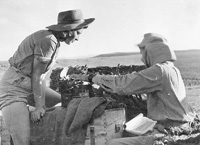By Dan Aznoff, Special to JTNews
History has been recorded by archeologists and scholars in every corner of Israel. American tourists who visit the Holy Land flock to the Western Wall and wait in line for the tram ride to the mountaintop fortress at Masada.
But part of the heritage of the land really comes alive inside the two-year-old Palmach Museum in Tel Aviv, where visitors follow a group of young recruits from the establishment of the fledgling rebel army until the end of the War of Independence.
There are no stagnant documents or displays here. Instead, the museum consists of a series of rooms that incorporate innovative staging, making the sights, sounds, feel and even smell of war real to its visitors.
“I felt like I was there witnessing history being made,” said Rabbi James Mirel, who led a group of 29 congregants from Bellevue’s Temple B’nai Torah on a 12-day tour of Israel that concluded on the Jewish State’s 60th anniversary. “The birth of Israel was a true miracle forged with the blood of brave men and women who gave their lives for an ideal [to] which they dedicated their lives.”
The museum is housed in a nondescript building situated along a major thoroughfare on the outskirts of the city, and is operated in cooperation with the Israeli Department of Defense. Even the uniformed soldier stationed at the entrance to the museum does not provide a clue into the drama housed behind the glass doors.
During their visit, TBT members marveled at the three-dimensional décor and film clips as each room gave life to members of the small band of freedom fighters. The story of independence begins with nights of clandestine training on kibbutzim under British rule in 1941 and follows each rebel’s role in the birth of the Israeli Defense Forces.
“Traditional museums with their glass cases and printed captions can get old. This museum was innovative and intrigued me from the moment we walked through door,” said TBT member Cliff Cantor.
The Palmach — or Strike Company — was established in the spring and summer of 1941 in anticipation of the army thought to be needed to defend the hoped-for future State of Israel against its hostile neighbors. The British encouraged and trained the provisional soldiers during World War II as homeland defense against the threat to Palestine from Nazi forces that marched across Northern Africa and into Egypt. The British eventually beat back the Germans in the African desert, and enlisted assistance from the Palmach to eventually seize control of Syria and Lebanon.
The militia began with 2,200 regular soldiers and 900 reservists. At its peak, the Palmach numbered more than 60,000 soldiers in eight battalions stationed throughout Palestine. One unit — known as the Balkan Unit — parachuted into Europe dressed as members of the enemy to augment the Allied march toward Germany.
Members of the Palmach went underground when the British officially disbanded the strike force in 1944. Several rooms in the museum are dedicated to the freedom fighters who worked on kibbutzim during the day and trained for warfare at night and on the Sabbath. One room portrayed how platoons prepared for war by sharing a single pistol with out-of-date munitions. The re-creation of night training on the kibbutz was enhanced with the smell of eucalyptus.
When the British attempted to suffocate the Zionist movement and denied the immigration of large numbers of Holocaust survivors from Europe between 1945 and 1947, the Palmach became an offensive assault force that undertook nighttime operations with an expertise in demolition. Covert operations bombed patrol boats in Jaffa Harbor, blew up 11 bridges leading to Arab neighborhoods, attacked coast guard stations in the Givat Olga and Sidney Ali neighborhoods, and destroyed the radar station on Mount Carmel.
The room that reenacted the demolition of a bridge captured the sights and sounds of the explosions, as well as the smell of gunpowder.
The 90-minute tour concludes with an emotional re-creation of the volunteer soldiers gathering around a console radio, which is tuned into the broadcast of the United Nations vote to establish the Jewish homeland, and the ensuing battle for sovereignty in 1948. The sights and smells of this last room are accompanied by the sounds of explosions that literally shook the seats and the floor.
The Palmach House, which includes the museum and a second floor library, was built by the Dor Hapalmach Association, an organization created to preserve, hold and teach the Palmach’s history to younger generations.
The building was handed over to the authority of the Ministry of Defense after its completion; it is now operated by the Department of Museums.
Tours of the museum are conducted in small groups. Individual visitors are merged with groups on a space-available basis only. Electronic audio speakers are provided in Hebrew, with translation available through remote headsets in English, Spanish, French and Russian.
The Memorial Room is located apart from the museum and away from the tours in an upstairs wing of the Palmach House. The room is composed of 1,170 drawers, one for each Palmach soldier who died in the battle for the young country from 1941 until 1949. Each drawer contains photographs, letters and any available personal details on the fallen comrade it is devoted to. A computer station outside the room enables friends and relatives to print any information contained in the files.
“The Palmach Museum brings to life the most exciting and harrowing days just before and after Israel’s independence in l948,” Rabbi Mirel said. “To be a free people in our land. For that reason alone, the museum was one of the highlights of our trip.”
Dan Aznoff is a freelance writer who lives in Bellevue and is an active member of Temple B’nai Torah.
